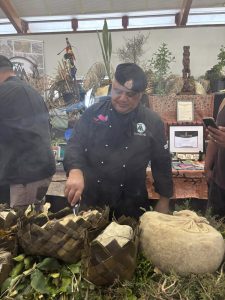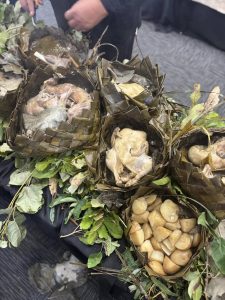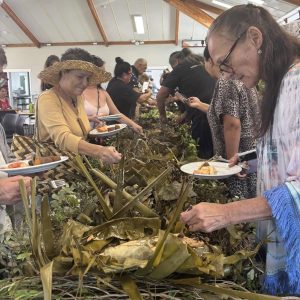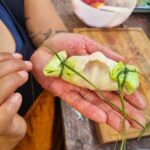He pitopito kōrero nā Arohanui West
Have you ever wondered what manaakitanga tastes like? How kaitiakitanga sits on your tastebuds? The weight of whakapapa in your puku? Well, I found out when I was privileged to attend the ‘E Kai Māori’ wānanga run by the renowned Chef Joe McLeod, at Ōrākei Marae in Tāmaki Makaurau.

The three-day wānanga began with Matua Joe gathering native rau (leaves), which act as both rongoā (traditional Māori medicine) and enhance the flavour of the kai. Chef McLeod explained that originally, he would take his assortment of leaves with him when he hosted these wānanga across the motu; now he does it on-site. Recognising that our native flora and fauna differ from iwi to iwi, hapū to hapū, and one of the most crucial elements of honouring our kai is learning how to gather and cook the kai that grows in your rohe.
The cohort then used their hauhake (harvest) to weave rourou kai (food baskets) from harakeke (flax). These rourou were filled with kai and adorned with native leaves such as kawakawa, rewarewa, rangiora, mānuka and horopito.

Throughout this process, we were reminded of the ingenuity of our tūpuna (ancestors). From following manu (bird) to understand their diet and know what food to pair the manu with in the cooking process; placing empty hue (gourd) in hot sand to increase its longevity as a storage vessel for liquid and kai; to the fermentation processes of seafood, meats and vegetables to store kai for slower, colder months.
On the third day, I shared a short presentation on behalf of Para Kore. I spoke about the interconnectedness of our food systems and how, by eating from our local foodscapes, we can connect ourselves to our whakapapa.
Every time we eat from our awa, roto, maunga, ngāhere and maara kai, we get a glimpse into the life of our tūpuna. We decolonise our tastebuds from refined sugars and processed kai. We care for these places more deeply because we actively spend time in them. We recognise them as our pātaka kai and acknowledge our dependence on them – if the moana is healthy and abundant with kai, then we are healthy too.

My wero to us all is this: what would life look like if we had to gather, grow, hunt, store and cook kai ourselves? How would our relationship with kai change? If we want to return to these ways of our tūpuna, living in accordance with te taiao, we must involve everyone. From the kaumātua who know the best fishing spots, the kuia who can weave a mean kupenga (net), the young people who are eager to get out for a hunt or a dive, the plant identification experts who know the horopito hot spots, and the ringawera who can take all of that kai and create a hākari for everyone to enjoy. It takes a village.
We completed our wānanga with a feast of kūmara, potatoes, stuffing, salmon, kūtai (mussels), kingfish, pikopiko, chicken, beef, and even possum, all wrapped up in rourou kai and flavoured with our native leaves. He reka rawa atu!
Ka kore e mutu ngā mihi ki a Matua Joe me tana rōpū a E Kai Māori. Kua rangatira mātau i a koutou wānanga.
Ngā manaakitanga,
Arohanui
Programmes:

He Mana tō te Kai is a journey to reconnect with kai, whenua, and whakapapa. This programme supports the restoration of traditional food practices, from growing and gathering, to preparing, storing, and sharing. Guided by values like manaakitanga, kaitiakitanga, and māramatanga, we explore how kai can nourish not only our bodies, but our whenua, relationships, and futures. Together, we reclaim kai as taonga, not waste.
